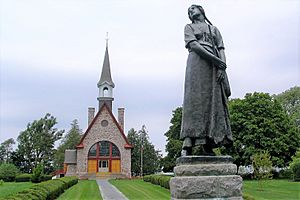Grand-Pré National Historic Site facts for kids
Quick facts for kids Grand-Pré National Historic Site |
|
|---|---|

Statue of Longfellow's Evangeline (by Louis-Philippe Hébert) and memorial church (by René-Arthur Fréchet)
|
|
| Location | Grand-Pré, Nova Scotia |
| Governing body | Parks Canada |
| Official name: Landscape of Grand Pré | |
| Type | Cultural |
| Criteria | v, vi |
| Designated | 2012 (36th session) |
| Reference no. | 1404 |
| Country | Canada |
| Region | Europe and North America |
| Official name: Grand-Pré National Historic Site of Canada | |
| Designated | 1982 |
| Official name: Grand-Pré Rural Historic District National Historic Site of Canada | |
| Designated | 1995 |
| Type | Heritage Conservation District |
| Designated | 1999 |
| Reference no. | 29MNS0002 |
| Lua error in Module:Location_map at line 420: attempt to index field 'wikibase' (a nil value). | |
Grand-Pré National Historic Site is a special park in Nova Scotia, Canada. It remembers the Acadian people who lived in the Grand-Pré area from 1682 to 1755. It also marks the sad time when the British moved the Acadians away during the French and Indian War. The first village of Grand-Pré stretched about four kilometers between what are now Wolfville and Hortonville. Today, Grand-Pré is a World Heritage Site and an important National Historic Site.
Contents
The Story of Grand-Pré: Early Settlement
Grand-Pré means "great meadow" in French. It is located by the Minas Basin, an area with lots of marshland. The first settlers arrived around 1680. Pierre Melanson and his family came from Port-Royal. Port-Royal was the first capital of the French settlement called Acadia.
Pierre Melanson and other Acadians built special walls called dykes. These dykes held back the high tides from the Minas Basin. This helped them create rich fields for their crops and pastures for their animals. Grand-Pré became very important for growing food in Acadia. It soon grew bigger than Port-Royal. By the mid-1700s, it was the largest Acadian community. Many Acadian villages were found around the Bay of Fundy and the coast of Nova Scotia.
Conflicts and Changes
During Queen Anne's War, in 1704, Major Benjamin Church attacked Grand-Pré. He burned the entire village. After this war, in 1713, part of Acadia became Nova Scotia. Port-Royal was renamed Annapolis Royal and became the capital. For the next 40 years, the Acadians did not want to promise full loyalty to the British king. Some worried about their religion. Others feared their Native allies or did not want to fight against the French. Some simply did not like the British.
During King George's War, the French tried many times to get Acadia back. The British tried to control the Bay of Fundy area. But local Acadians, Mi'kmaq, and Canadiens defeated them in the Battle of Grand Pre.

Father Le Loutre's War started when Halifax was built in 1749. Halifax became the new capital. The British built Fort Vieux Logis at Grand-Pré. But a group of Mi'kmaq and Acadian militia attacked it in the Siege of Grand Pre.
The Great Upheaval
During the French and Indian War, the British wanted to stop any military threat from the Acadians. They also wanted to cut off supplies the Acadians sent to Louisbourg and the Mi'kmaq. So, the British decided to move the Acadians out of Acadia. This event is known as the Expulsion of the Acadians.
After the Battle of Fort Beauséjour, the British began moving the Acadians. On August 19, 1755, Lieutenant Colonel John Winslow arrived in Grand-Pré with his soldiers. He set up his headquarters in the church. Winslow also built a fence around the area. On September 5, the men and boys of the area were told to come to the church. Winslow told them that everything they owned, except their personal items, would be taken by the British. He said they and their families would be moved as soon as ships arrived. At the same time, Acadians in the nearby village of Pisiguit heard the same news at Fort Edward.
Some Acadians managed to escape being moved. They continued to fight against the British during the expulsion. However, in the first year, over 6,000 Acadians were moved from the Bay of Fundy area. Many villages were burned down so the Acadians could not return. Thousands more were moved in a second wave of expulsions. This included Acadians from Cape Breton and Prince Edward Island in 1758. The expulsions continued until England and France made peace in 1763. In total, about 12,000 Acadians were moved. Many Acadians died from drowning, hunger, being held captive, and from being exposed to harsh weather.
Evangeline: A Famous Poem
In 1847, a poem called Evangeline was published in the United States. It was written by Henry Wadsworth Longfellow. This poem told the story of the Acadian Expulsion, also known as "le Grand Dérangement" (the great uprooting), to the English-speaking world. Grand-Pré had been mostly forgotten for almost 100 years. But after the poem, it became popular for American tourists. They wanted to visit the place where Evangeline, the poem's main character, was from. However, nothing of the original village remained except the dyked lands and some old willow trees. There is a statue of Henry W. Longfellow at the site.
In 2018, a Canadian historian and writer named A. J. B. Johnston wrote a young adult novel called The Hat. It was inspired by what happened at Grand-Pré in 1755. This novel does not mention Evangeline. Instead, it focuses on two made-up characters, 14-year-old Marie and 10-year-old Charles.
Protecting the Site
John Frederic Herbin's Efforts
In 1907, John Frederic Herbin bought the land believed to be where the church of Saint-Charles once stood. Herbin was a poet, historian, and jeweler, and his mother was Acadian. He wanted to protect the land. The next year, Nova Scotia passed a law to create the Trustees of the Grand-Pré Historic Grounds. Herbin built a stone cross on the site to mark the church's cemetery. He used stones from what he thought were old Acadian building foundations.
The Dominion Atlantic Railway's Role
Herbin sold the property to the Dominion Atlantic Railway in 1917. He made sure that Acadians would be involved in protecting it. Acadian history was already a big draw for tourists on the Dominion Atlantic Railway. The Grand-Pré site was right next to the railway's main line. The railway spent a lot of money to develop the park. They also promoted the history and stories of the Acadians. Beautiful gardens were planted at the site, and a small museum was opened.
In 1920, the Dominion Atlantic Railway put up a statue of Evangeline. It was designed by Canadian sculptor Louis-Philippe Hébert and finished by his son Henri after his death. The railway also gave a piece of land, and money was raised to build a memorial church in Grand-Pré. Construction started in the spring of 1922, and the outside was finished by November. The inside of the church was completed in 1930. This was the 175th anniversary of the Expulsion. The church then opened as a museum.
Parks Canada Takes Over
Over time, fewer people traveled by train as more highways were built. So, the Dominion Atlantic Railway sold the park to the Canadian government in 1957. The Canadian Parks Service took over running the park. It was officially named a National Historic Site in 1982. The Visitor Reception and Interpretation Center has exhibits about the history of Grand-Pré and Acadia. A video also tells the story of the Acadian deportation.
Digging Up the Past: Archaeology
Grand-Pré National Historic Site is also a place where archaeologists dig to learn more. St. Mary’s University, Parks Canada, and Sociéte Promotion Grand-Pré work together on these digs. Parks Canada has been digging since 1971. For ten years, a field school has been active there. Archaeologists have found the cemetery from the Acadian period. They also found the basement of an Acadian house next to the Memorial Church. They have dug test pits all over the site looking for signs of the parish church, St-Charles-des-Mines.
They have found many Acadian items. These include pieces of pottery, nails, wine bottle glass, window glass, and a French silver coin from 1711. They also found spoons, belt buckles, buttons, and clay pipes. There is also evidence that New England troops stayed there. And there is a lot of evidence from the time when New England Planters lived there, starting in 1760.
Special Historic Recognitions
The "Landscape of Grand Pré" was named a World Heritage Site by UNESCO on June 30, 2012. It had been on Canada's list of possible World Heritage Sites since 2004. The 1,300 hectares (about 3,200 acres) of marshland and archaeological sites in Grand-Pré were recognized. They are seen as a great example of how the first European settlers adapted to the Atlantic coast of North America. They are also a reminder of the Acadian way of life and their forced removal.
In 1982, it was 300 years since the first Acadians arrived in the region in 1682. To mark this, the Grand-Pré memorial park was named the "Grand-Pré National Historic Site." This was to remember the Acadian settlement and their later removal. In 1995, the site and the area around it were named the "Grand-Pré Rural Historic District National Historic Site." This honored the rural cultural landscape. It shows one of the oldest ways Europeans used land in Canada.
The "Grand Pré Heritage Conservation District" was created in 1999. This was done under Nova Scotia's Heritage Property Act. It includes the area in and around the small village of Grand-Pré, as well as the Grand-Pré National Historic Site.
See also
 In Spanish: Paisaje cultural del Grand Pré para niños
In Spanish: Paisaje cultural del Grand Pré para niños
- Nova Scotia Heritage Day

